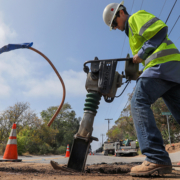Water pipeline blowouts like the one the day before Thanksgiving 2017 at the intersection of Stagecoach Road and Ranchwood Lane in Fallbrook provide periodic reminders about the realities of aging infrastructure.
Preventing these type of emergencies is the driving force behind planned shutdowns at water agencies such as the Fallbrook Public Utility District; investments today will avoid similar emergencies and unplanned water outages in the years ahead.
Many of FPUD’s pipes are more than 50 years old. A pipeline’s life can be 80 to 100 years, but many of the early lines that were installed were not put in at today’s standards and have shorter lives.
In fact, some of the early pipelines installed in the area were originally excavated from March Air Force Base in Riverside County and re-installed in Fallbrook, said FPUD general manager Jack Bebee. Many of these pipelines have reached the end of their useful lifespans.
That’s why FPUD is embarking on a number of prevention, maintenance and improvement projects to safeguard and maintain our pipes and infrastructure. Waiting to fix them after they break isn’t the most cost-effective and convenient way to operate.
“We’re trying to prevent a continued Band-Aid approach,” said Bebee.
Proactive approach prioritizes greatest need first
The shutdowns and retrofits are part of FPUD’s proactive approach to pipeline and valve replacement. By identifying pipes that are in the worst condition, the agency is prioritizing those needing to be replaced first, resulting in fewer pipe failures, blowouts and spills.
As part of its ongoing maintenance program, FPUD has refurbished six of its eight steel tanks over the past several years. It is also working on systematic valve replacement covering the entire community area. Valves are a critical component of water and sewer system infrastructure to limit the size of any shutdown.
Annually, the district also replaces or relines sewer manholes and sewer lines. Some of the manholes date so far back they are made of brick. Only FPUD’s sewer customers pay for sewer improvements, and only water customers pay for water improvements.
All FPUD construction work will be on weekdays between 7 a.m. and 4:30 p.m., with an exception for projects that disrupt businesses. Those projects may be scheduled overnight. FPUD customers will receive both a letter and phone call if the planned shutdown will affect their water service.
FPUD posts regular updates to its website at www.fpud.com and on its Twitter account, @Fallbrook water
Residents can also visit the FPUD Facebook page for other water-related updates.



